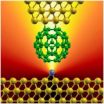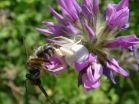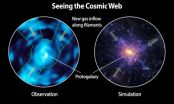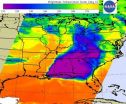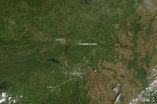(Press-News.org) Carbon-based nanostructures such as nanotubes, graphene sheets, and nanoribbons are unique building blocks showing versatile nanomechanical and nanoelectronic properties. These materials which are ordered in the nanoscale, that is, in the dimension of a millionth of millimetre, are promising candidates to envision applications in nanoscale devices, ranging from energy conversion to nano-electronic transistors. A good connection between carbon-based materials and external metallic leads is of major importance in nanodevice performance, an aspect where an important step has been surmounted by researchers from UPV/EHU, DIPC and CNRS by studying contacts of carbon nanostructures with atoms of different chemical nature.
The chemical nature of contacting leads is of major importance as it affects the electronic properties and the geometry of the contact. The impact of these two aspects on the transport properties are entangled and this group studied these two parameters for contacts shrunk to the limit of individual atoms as for large structures it is challenging to address them separately.
In close collaboration, the researchers used a prototype carbon-based molecule made of 60 carbon atoms arranged in a sphere that can be viewed as a graphene sheet rolled into a tiny ball. The experimental team in Strasbourg led by Guillaume Schull, attached this molecule to the apex of an extremely tiny metal needle of a scanning tunnelling microscope. The molecule-terminated needle was then cautiously approached to individual metallic atoms of different chemical nature up to the formation of a robust connection. By simultaneously measuring the electrical current passing through these connections, they could deduce which of the individual metallic atom is injecting charges to the carbon-made molecule with the greatest efficiency.
Large-scale computer simulations performed by the theoretical team in San Sebastian led by Thomas Frederiksen, Ikerbasque Research Professor at the DIPC, revealed a fascinating and unexpected aspect of these extremely tiny connections: their electric and mechanical properties are in fact representative for much larger carbon-based materials.
These results, published in the prestigious journal Nature Communications, set the bases to find extremely efficient contacts in the near future. The study paves the way to probe a great number of different metallic species (as well as tiny alloys made of two or three different metallic atoms), allowing for a systematic classification of their abilities to inject electrons into emerging carbon-based electronic devices.
INFORMATION:
Full research publication (open access):
Chemical control of electrical contact to sp2 carbon atoms
T. Frederiksen, G. Foti, F. Scheurer, V. Speisser, & G. Schul. Nature Communications (2014).
DOI: 10.1038/ncomms4659
A small connection with big implications: Wiring up carbon-based electronics
Research carried out at UPV/EHU, DIPC and CNRS advances the understanding of electric contacts in future carbon-based nanoelectronics
2014-04-30
ELSE PRESS RELEASES FROM THIS DATE:
Like puzzle pieces, 3-D genomics holds a key to classifying human diseases
2014-04-30
To solve a puzzle, you need to recognize shapes, patterns and a particular kind of order. In much the same way, researchers at McGill University have discovered that the 3D shape of a leukemia cell's genome holds a key to solving the puzzle of human diseases. The researchers report their findings in the open access journal Genome Biology.
McGill professor Josée Dostie, a researcher in the Faculty of Medicine in the department of Biochemistry, focused on the shape made by the region spanning the Homeobox A (HOXA) genes in human cells -- a set of 11 genes encoding proteins ...
Safe(bee) in numbers
2014-04-30
Bumblebees can distinguish between safe and dangerous environments, and are attracted to land on flowers popular with other bees when exposed to perilous situations, according to new research from Queen Mary University of London.
The study published in the journal Proceedings of the Royal Society B, shows that past experience of predation causes bumblebees to join other bees already safely feeding on flowers.
Co-author and PhD student Erika Dawson said: "Our experiment shows for the first time that when bees find themselves in these predator-infested environments ...
Molecular networks provide insights for computer security, Carnegie Mellon finds
2014-04-30
PITTSBURGH—The robust defenses that yeast cells have evolved to protect themselves from environmental threats hold lessons that can be used to design computer networks and analyze how secure they are, say computer scientists at Carnegie Mellon University.
Environmental "noise" is a key evolutionary pressure that shapes the interconnections within cells, as well as those of neural networks and bacterial/ecological networks, they observe in a paper to be published online April 30 by the Journal of the Royal Society Interface. The researchers factored this into an established ...
Bigger is not always better, but it helps, says new research on beetles
2014-04-30
Researchers at the University of Exeter have found that the probability of a burying beetle winning fights, for the small animal carcasses it needs, depends on a combination of early life experiences and the competition it faces as an adult.
These beetles use small dead animals, such as mice and songbirds, to provide food for their young and competition for a carcass can be fierce.
Previous work has found that success in such contests depends on how good your early adult life environment was, not just how big you are. However, in many animals food availability can ...
The intergalactic medium unveiled: Caltech's Cosmic Web Imager
2014-04-30
Caltech astronomers have taken unprecedented images of the intergalactic medium (IGM)—the diffuse gas that connects galaxies throughout the universe—with the Cosmic Web Imager, an instrument designed and built at Caltech. Until now, the structure of the IGM has mostly been a matter for theoretical speculation. However, with observations from the Cosmic Web Imager, deployed on the Hale 200-inch telescope at Palomar Observatory, astronomers are obtaining our first three-dimensional pictures of the IGM. The Cosmic Web Imager will make possible a new understanding of galactic ...
Stem cells aid heart regeneration in salamanders
2014-04-29
SAN DIEGO (April 29, 2014) – Imagine filling a hole in your heart by regrowing the tissue. While that possibility is still being explored in people, it is a reality in salamanders. A recent discovery that newt hearts can regenerate may pave the way to new therapies in people who need to have damaged tissue replaced with healthy tissue.
Heart disease is the leading cause of deaths in the United States. Preventative measures like healthful diets and lifestyles help ward off heart problems, but if heart damage does occur, sophisticated treatments and surgical procedures ...
Study confirms increased prevalence of GI symptoms among children with autism
2014-04-29
A new study conducted by researchers at Marcus Autism Center, Children's Healthcare of Atlanta and Emory University School of Medicine indicates that children with autism spectrum disorder (ASD) are more than four times more likely to experience general gastrointestinal (GI) complaints compared with peers, are more than three times as prone to experience constipation and diarrhea than peers, and complain twice as much about abdominal pain compared to peers.
The results were reported in the April 28, 2014, online early edition of the journal Pediatrics.
While parents ...
NASA satellite sees colder temperatures at tops of severe weather thunderstorms
2014-04-29
The weather system that dropped tornadoes in seven central and southern U.S. states on April 27-28, moved east and generated more tornadoes on April 29. NASA's Aqua satellite gathered temperature data on the thunderstorm cloud tops in the system and found them to be higher in the atmosphere and colder. The tornado outbreak over the evening and overnight hours of April 28-29 is thought to have generated more tornadoes in northern Mississippi and Alabama.
NASA's Aqua satellite passed over the eastern U.S. early in the morning on April 29 at 07:41 UTC/3:41 a.m. EDT and gathered ...
Search for extraterrestrial life more difficult than thought
2014-04-29
A new study from the University of Toronto Scarborough suggests the search for life on planets outside our solar system may be more difficult than previously thought.
The study, authored by a team of international researchers led by UTSC Assistant Professor Hanno Rein from the Department of Physical and Environmental Science, finds the method used to detect biosignatures on such planets, known as exoplanets, can produce a false positive result.
The presence of multiple chemicals such as methane and oxygen in an exoplanet's atmosphere is considered an example of a ...
NASA satellite spots tornado track near Conway, Ark.
2014-04-29
A violent tornado touched down in Arkansas on April 27, 2014, killing as many as 15 people. The top image, acquired on April 28 by the Moderate Resolution Imaging Spectroradiometer (MODIS) on NASA's Aqua satellite, shows what appears to be a tornado track north of Little Rock, Arkansas. The lower image, from April 25, shows the same area before the storm. The tracks are pale brown trails where trees and plants have been uprooted, leaving disturbed ground.
The difference in clarity between the two images is likely due to the centering of the scene beneath the satellite. ...
LAST 30 PRESS RELEASES:
Making lighter work of calculating fluid and heat flow
Normalizing blood sugar can halve heart attack risk
Lowering blood sugar cuts heart attack risk in people with prediabetes
Study links genetic variants to risk of blinding eye disease in premature infants
Non-opioid ‘pain sponge’ therapy halts cartilage degeneration and relieves chronic pain
AI can pick up cultural values by mimicking how kids learn
China’s ecological redlines offer fast track to 30 x 30 global conservation goal
Invisible indoor threats: emerging household contaminants and their growing risks to human health
Adding antibody treatment to chemo boosts outcomes for children with rare cancer
Germline pathogenic variants among women without a history of breast cancer
Tanning beds triple melanoma risk, potentially causing broad DNA damage
Unique bond identified as key to viral infection speed
Indoor tanning makes youthful skin much older on a genetic level
Mouse model sheds new light on the causes and potential solutions to human GI problems linked to muscular dystrophy
The Journal of Nuclear Medicine ahead-of-print tip sheet: December 12, 2025
Smarter tools for peering into the microscopic world
Applications open for funding to conduct research in the Kinsey Institute archives
Global measure underestimates the severity of food insecurity
Child survivors of critical illness are missing out on timely follow up care
Risk-based vs annual breast cancer screening / the WISDOM randomized clinical trial
University of Toronto launches Electric Vehicle Innovation Ontario to accelerate advanced EV technologies and build Canada’s innovation advantage
Early relapse predicts poor outcomes in aggressive blood cancer
American College of Lifestyle Medicine applauds two CMS models aligned with lifestyle medicine practice and reimbursement
Clinical trial finds cannabis use not a barrier to quitting nicotine vaping
Supplemental nutrition assistance program policies and food insecurity
Switching immune cells to “night mode” could limit damage after a heart attack, study suggests
URI-based Global RIghts Project report spotlights continued troubling trends in worldwide inhumane treatment
Neutrophils are less aggressive at night, explaining why nighttime heart attacks cause less damage than daytime events
Menopausal hormone therapy may not pose breast cancer risk for women with BRCA mutations
Mobile health tool may improve quality of life for adolescent and young adult breast cancer survivors
[Press-News.org] A small connection with big implications: Wiring up carbon-based electronicsResearch carried out at UPV/EHU, DIPC and CNRS advances the understanding of electric contacts in future carbon-based nanoelectronics
